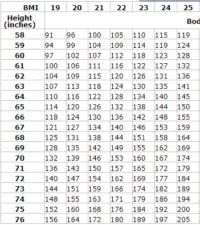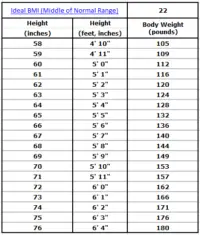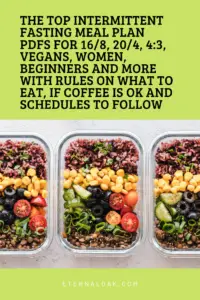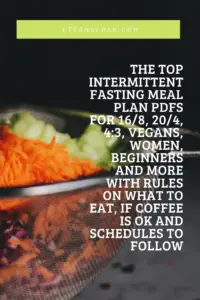This is part 2 of the Intermittent Fasting Meal Plan PDF guide.
You can read part one here: Intermittent Fasting Meal Plan PDF [Part 1 of 2]
Table of Contents
What foods can you eat during intermittent fasting?
For most fasts you only want to drink non-caloric beverages – water, plain tea, black coffee, or diet drinks.
For some types of fasting, like 5:2 or Alternate Day Fasting, you will eat 500 calories on your fast day.
For a full explanation on how many calories break a fast see our article on it here: How Many Calories Break a Fast
Can I drink coffee during intermittent fasting?
Absolutely. It’s highly recommended. Like warm tea it helps reduce hunger.
Most feel like that’s due to the caffeine but that was disproven in this study. In that study they gave people caffeinated and decaffeinated coffee and had them rate how hungry they were after. Both reduced hunger.
The researchers attributed it some other ingredient from the coffee beans. It’s unknown why coffee reduces hunger but it does.
So when you’re fasting drink up! You can also have plain tea and diet drinks; however, my experience with diet drinks is that they can sometimes increase hunger.
It does this for me. Why? I don’t know. It may be that I associate it with eating since I usually have diet soda with a meal when I drink it.
You might find the same will happen to you with coffee. Perhaps you drink it only with breakfast. Your mind will expect food while you drink it and thus it might make you hungry.
Fasting will teach you alot about what triggers your hunger. The fun part is you can change all of those things. You can unlearn old hunger triggers and start new ones.
My favorite hunger trigger? Following a meal plan on a set schedule. Then those times of day become hunger triggers. I can deal with that on fasting days by staying busy at those times, traveling, or drinking hot tea or coffee. I recommend you do the same.
What should I eat during intermittent fasting to lose weight?
Eat nothing! Drink only black coffee, plain tea, or water. This is what works for me with my fasts and what I recommend for you.
If hunger is too much during your fast then fear not. Fasting is a learned skill. You have to practice it to master it.
When you combine fasting with a meal plan you are setting yourself up to win. You won’t worry about hunger. You’ll know when it’s coming and you’ll stay busy. See these tips on dealing with hunger during a fast.
If you’re doing a 5:2 or Alternate Day Fast you’ll be eating 500 calories of food during your fasting days. You should stick with your meal plan.
Have 500 calorie meals planned in advance. There’s no right or wrong foods and I say that with caution.
Yes, you could follow the twinkie diet on your fasting days and just eat 500 calories of twinkies. But will they fill you up? Will they satisfy you? Or will they just make you crave more sugar later in the day?
Likely the latter.
Choose foods that fill you up and keep you satisfied as long as possible if you have a 500 calorie meal for your fasting day.
I recommend plain potatoes. See our article on the Potato Diet Hack. Plain boiled potatoes are the number one filling food according to this study. Unlike twinkies or a tasty sandwich, they won’t trigger hunger later in the day.
In fact, the Potato Diet is truly a form of fasting. You only eat potatoes. They’re filling yet not exciting, so you only eat them when you are really really hungry.
If going a day without eating is too tough try these 2 options:
- Do shorter fasts and build up to longer fasts over time. Treat it like a muscle and work it out.
- Try the potato diet on your fasting days. For the day of the fast only eat plain potatoes with a little salt. You will still drop weight similar to fasting. It just might take longer.
Find the fasting path that you can maintain. This is your journey. Your adventure. Only you can know what works for you through testing, observation, and tweaking until you find the perfect path for you.
Calories per meal
Let’s keep this super simple.
I always wanted to break down calories per meal based on your height and age then show it in a chart so it was easy to lookup.
It doesn’t matter if you’re male or female.
Your height is a very rough estimation of your lean body mass. That’s the part of you that uses the most calories just maintaining itself.
Since most people aren’t bodybuilders, complicated formulas aren’t necessary.
Let us begin.
Wait, wait, wait. I just tried to do this online. What a mess!
Most of the calculators out there don’t reference the studies behind their formulas. Most don’t even show their formulas!
Furthermore there’s a crazy range you could get.
When I first started my weight loss journey I did something crazy simple.
I looked up my BMI range. Yes, it’s a fairly huge range.
Normal weight BMI for anyone is from 18.5 to 24.9.
I first chose a BMI calculator from the National Institute of Health (NIH). Ugly calculator but trust-able! Personally I prefer their chart. It’s faster.

The Chart above only shows the normal weight range with BMIs from 18.5 to 24.9. It doesn’t matter where you are now.
In order to calculate your ideal calories per meal we’re going to Use the middle of your BMI for your height. That would be a BMI of 22. That chart would look like this.

I am 5’10.5”. Sadly, in the health world that extra half inch of height is never counted. You’re either 5’10” or 5”11”. As a nurse once told me, she can’t make up that last half inche so 5’10” it was for me.
We’ll do the same for the calculator. I recommend the same for you – round down. You’ll get a more conservative number and it’ll be easier to reach your weight loss goals.
At 5’10”, the NIH says my ideal BMI of 22 would put me at 153 pounds.
Next we take our height, age, and BMI weight and plug it into a calorie calculator. Again, we use the one from NIH to stay consistent.
Unfortunately this is where it gets complicated. It asks for daily exercise, current weight, goal weight, blah, blah, blah.
We’re getting rid of all that.
We assume sedentary, the lowest setting in the calculator.
We want to know the calories as if we were that weight right now. No suffering. Just tell me how much I should eat per meal based on my height, age, and sex.
So instead of having you plug all that in we made this cheat sheet table.

Next we assumed you would eat 3 meals a day. We divide the above daily calories by 3 to get this chart. This gives you how much your ideal meal would be. Design your recipes to this number.

Obviously this table doesn’t include all ages or heights. That table would be a monster.
Instead we jumped decades. We also jumped every 3 inches.
Yellow shows the average female height in the US.
Orange shows the average male height in the US.
We started there and branched out 3 inches in either direction.
This won’t include everyone. It shouldn’t. You shouldn’t rely on calculators like this 100%.
Use it as a starting place to get a rough number.
Design your recipes to match these rough numbers.
Then implement your meal plan. Every week measure your waist circumference in centimenters and your weight in either pounds or kilograms. Centimeters will show progress faster than inches. Since it’s a smaller unit it’ll be easier to measure accurately from week to week.
If things aren’t progressing as you want adjust the calorie number down by 50 calories.
Real life measurement of calories is hard.
You can’t trust the numbers on the package.
You can’t trust the numbers in Myfitnesspal.
These are all just rough estimates.
Consider them a heading on your compass towards weight loss.
The goal is to get your average in that direction and hold it over time.
However you count will be consistent to you. It doesn’t have to be perfectly accurate.
If you’d done all these calculations and it’s not working just lower your per meal calorie count by 50 calories and keep going.
There’s no need to count calories as you go. Just do one of the following:
- Design recipes based on your favorite meals that meet the calorie estimate per meal
- Choose frozen meals from the grocery store that meet these calories
- Choose meals from meal prep places like Freshly that meet your calories
- Find restaurants with meals that meet your calories.
Once you’ve find your core meals that meet your calories you’re ready for action.
To download the spreadsheet’s we used to make these charts click here: Quick BMI Charts Spreadsheet
How to Set Your Fasting Schedule
See the section on How Much Weight you can Lose in a month with intermittent fasting.
The schedule you choose is based on your lifestyle, not your goals.
They all lead to the same place.
If you like to party or have big eating nights out several times a week you will need to add in a 24 or 36 hour fast.
If you can maintain compliance you can just do the 16:8 daily with a meal plan.
You can have an early 16:8 or a late 16:8. There are studies to back up both early and late plans. Choose the late plan if dinner with family is important. Choose the early plan, like I do, if it’s easier to skip evening snacks and meals.
How many hours of fasting before body burns fat?
You are burning fat all the time. The secret is to stop eating every now and then (i.e. stop snacking)! This question stems from the world of keto. Your body will switch over to burning fat primarily for all energy after a certain number of hours.
In general the body does this after you stop eating.
- Eating stops
- The body uses glucose in your blood
- The body starts releasing glycogen from your liver and your muscles to burn – 0 – 12 hours
- After roughly 12 – 24 hours all glycogen will be consumed.
- During that 0 – 24 hours of burning off glycogen your body is slowly ramping up fat burn
- During that first 0 – 24 hours there will be a small amount of muscle burn. The body will stop this by releasing large amounts of human growth hormone to preserve muscle. Great time to lift weights!
- Somewhere between 24 – 48 hours you will be mostly burning fat stores.
- Eat again. The body turns carbs to glucose and uses that primarily and stores the excess as glycogen (not fat).
- Stop eating and you repeat steps 2 through 7.
The issue with the above is snacking. Snacking never lets your body fully consume the glucose in your blood and the excess glycogen in your muscles and liver.
Best Ways to Track Your Fasts
There are a ton of ways to track your fasts. I don’t even track mine. I set my meal times to regular day times and don’t eat past 5 PM. Easy done.
You may want to record your fasting times to build the habit.
See our blank meal plan above. It comes with blank slots to enter your meal times and your fasting time.
There are also a ton of apps out there for habit tracking. Some are even for intermittent fasting tracking.
My favorite Habit tracking app is Habitica. It’s cartoon and role play gaming themed which is great for the nerdier types like myself. As you complete your daily habits it adds experience poinds and gold to your character which you can use to buy new armor, weapons, etc. It’s fun to build up your character as you build up your habits. Another tiny free reward that will keep you motivated.
There are a ton of other habit tracking apps that would take another article to fill out. Some let you add a monetary reward or punishment for achieving or failing to achieve your goal.
Others use social pressure to help keep you on track.
For now, here’s a brief list of six specific to fasting.
The Top 6 Intermittent Fasting Apps
- Zero – Fasting Tracker on the App Store – iTunes – Apple
- MyFast – Intermittent Fasting Tracker Schedule App – Apps on Google …
- BodyFast Intermittent Fasting: Coach, diet tracker – Apps on Google Play
- Vora – Fasting Tracker – Apps on Google Play – most popular on reddit
- Fast Habit (IOS)
- Track Your Fast (Android)
Daily Challenges to Keep You on Track
Fasting and meal planning can be a bit boring. After a few weeks you’ve either built a habit and it’s easy to stick to or you find you’re a bit sick of the routine.
To help add a distraction to keep you going, 21 Day Hero built a fasting PDF that involves a different challenge every day. This could be a great help, especially after the first few weeks of setting the habit, just to keep it fun.
Remember, the core routine in this order:
- Core meals – eat the same set of 3-4 pre-planned meals at the same times daily. You can cook them at meal time or before. Just keep to the same times and meals
- Daily or weekly fasting – use 16:8 to prevent snacking and 24/36 hour fasts to balance out holidays or bigger eating during the week
Master those 2 first and if you’d like, add daily challenges for fun.
Now share these pins!!!!

